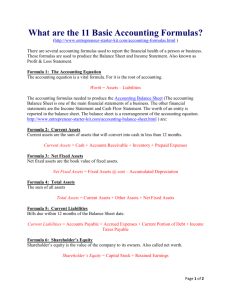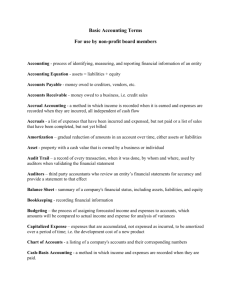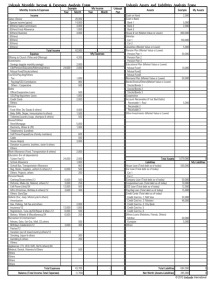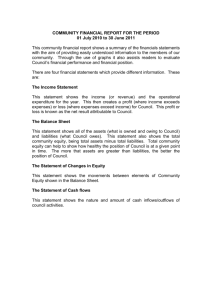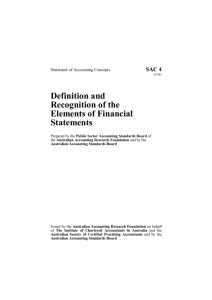Chapter 4: General Principles of Accounting
advertisement
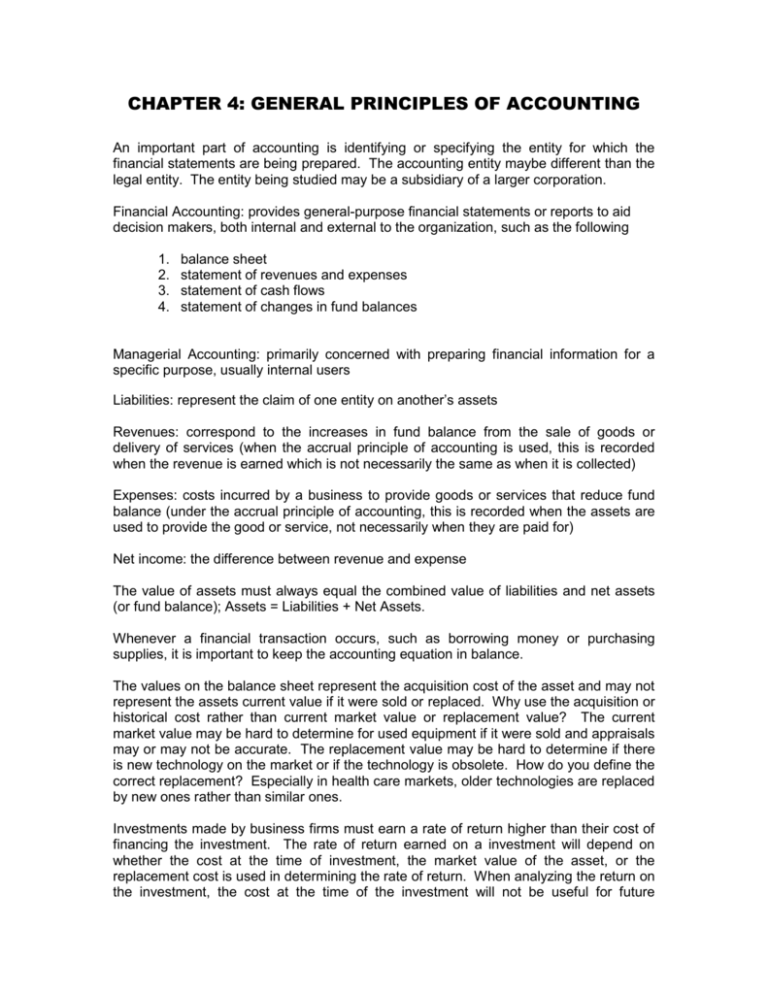
CHAPTER 4: GENERAL PRINCIPLES OF ACCOUNTING An important part of accounting is identifying or specifying the entity for which the financial statements are being prepared. The accounting entity maybe different than the legal entity. The entity being studied may be a subsidiary of a larger corporation. Financial Accounting: provides general-purpose financial statements or reports to aid decision makers, both internal and external to the organization, such as the following 1. 2. 3. 4. balance sheet statement of revenues and expenses statement of cash flows statement of changes in fund balances Managerial Accounting: primarily concerned with preparing financial information for a specific purpose, usually internal users Liabilities: represent the claim of one entity on another’s assets Revenues: correspond to the increases in fund balance from the sale of goods or delivery of services (when the accrual principle of accounting is used, this is recorded when the revenue is earned which is not necessarily the same as when it is collected) Expenses: costs incurred by a business to provide goods or services that reduce fund balance (under the accrual principle of accounting, this is recorded when the assets are used to provide the good or service, not necessarily when they are paid for) Net income: the difference between revenue and expense The value of assets must always equal the combined value of liabilities and net assets (or fund balance); Assets = Liabilities + Net Assets. Whenever a financial transaction occurs, such as borrowing money or purchasing supplies, it is important to keep the accounting equation in balance. The values on the balance sheet represent the acquisition cost of the asset and may not represent the assets current value if it were sold or replaced. Why use the acquisition or historical cost rather than current market value or replacement value? The current market value may be hard to determine for used equipment if it were sold and appraisals may or may not be accurate. The replacement value may be hard to determine if there is new technology on the market or if the technology is obsolete. How do you define the correct replacement? Especially in health care markets, older technologies are replaced by new ones rather than similar ones. Investments made by business firms must earn a rate of return higher than their cost of financing the investment. The rate of return earned on a investment will depend on whether the cost at the time of investment, the market value of the asset, or the replacement cost is used in determining the rate of return. When analyzing the return on the investment, the cost at the time of the investment will not be useful for future decision making. This will tell you how well the investment has done but will not tell you how it will do in the future. If the replacement value is used, this will tell whether a similar investment would do well in the future. CHAPTER 5: FINANCIAL STATEMENTS Balance Sheet Operating Cycle: length of time between acquisition of materials and services and collection of revenue generated by them Current Assets: assets that are expected to be exchanged for cash or consumed during the operating cycle of the entity (or one year, whichever is longer) 1. cash and cash equivalents (cash: currency, coins, negotiable instruments such as money orders or personal checks; cash equivalents: savings accounts, certificates of deposit, must be capable of being transformed into cash easily); used to meet normal daily demands for cash 2. accounts receivable (represent legally enforceable claims on customers for prior services or goods), represents the amount of money expected to be collected in the next year for services provided; usually different from the actual patient charges since most charges have some allowance that reduces the amount that will actually be paid (such as a charity allowance, courtesy allowance, or contractual allowance) 3. inventories/supplies: items that are to be used in the delivery of health care services such as normal office supplies to laboratory supplies 4. prepaid expenses: expenditures made for future service (such as prepayment of insurance premiums) Property and Equipment: fixed assets or plant property and equipment (capital assets), shown at the historical cost or acquisition cost adjusted for depreciation 1. land and improvements: represent the historical cost of land owned and any improvements made to it, land may not be depreciated but improvements may be 2. buildings and equipment: represent all buildings and equipment owned by the entity and used during the normal course of its operations; stated at historical cost; may be classified into three categories(fixed equipment, major movable equipment, minor equipment) 3. construction in progress: money expended on projects not yet complete at the time the statement is prepared 4. allowance for depreciation: represents the accumulated depreciation taken on the asset to the date of the financial statement Assets That Have Limited Use: certain funds may be restricted by the board, some may be restricted by a third party Other Assets: not current and do not involve property and equipment, usually either investments or intangible assets Current Liabilities: obligations that are expected to require payment in cash during the coming year or operating cycle (whichever is longer) 1. accounts payable: represent the entity’s promise to pay money for goods or services it receives 2. accrued liabilities: obligations that result from prior operations (a legal obligation to make future payment, such as interest) 3. current portion of long-term debt: represents the amount of principal that will be repaid on the indebtedness within the coming year (not the total payment for the year since that would include both the interest and principal payment) Non-Current Liabilities: include obligations that will not require payment in cash for at least one year or more, such as accrued retirement costs or long-term debt Accrued Insurance Costs: represents the present value of expected or estimated claims that the organization will be responsible for paying Long-Term Debt: represents the amount of long-term indebtedness that is not due in the next year Unrestricted Net Assets: represent the difference between assets and the claim to those assets by third parties or liabilities Statement of Revenues and Expenses Revenue: in healthcare it usually comes from three sources 1. patient services revenue: represents the amount of revenue that results from the provision of health care services to patients, the amount expected to be collected from the patient services provided, actual charges are usually higher and then reduced for contractual allowances and charity care; some of this is estimated at the end of the year for payments that have not actually been received but payment from third-party payers is expected under contractual arrangements (a) contractual allowances: difference between hospital charges and the amounts that certain payers have agreed to pay (b) charity care: represents services provided for which payment was never expected (different from bad debt) (c) bad debt: incurred on patients for whom services were provided and payment was expected, but no payment was made, they are not deducted from revenue but reported as an expense 2. other revenue: generated from normal day-to-day operations not directly related to patient care, such as (a) (b) (c) (d) (e) research and grants rentals of space and equipment sales of medical and pharmacy items to non-patients cafeteria or gift shop sales investment income from malpractice trust funds 3. non-operating gains (losses): gains and losses result from peripheral or incidental transactions, the following are often categorized as non-operating gains or losses (a) (b) (c) (d) contributes or donations that are unrestricted income from endowments income from the investment of unrestricted funds gains or losses on sale of property net rental of facilities not used in the operation of the facility Operating Expenses: there are two ways that expenses may be categorized (1) by cost or responsibility center or (2) by object or type of expenditure; usually reported by cost object; the following categories may be included 1. 2. 3. 4. 5. 6. 7. salaries and wages fringe benefits professional fees supplies interest bad debt expense depreciation (an allocation for the cost of the decline in value or productivity) and amortization (the allocation of the cost of an intangible asset over its lifetime) 8. restructuring cost Expenditures and expenses may not be equal in any given year



